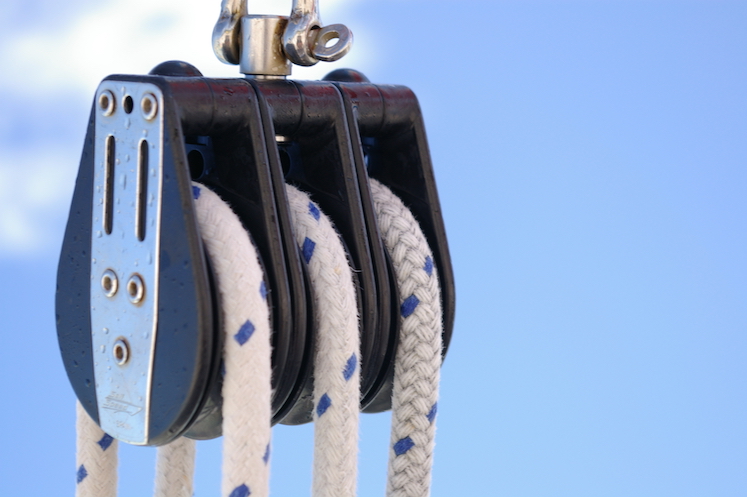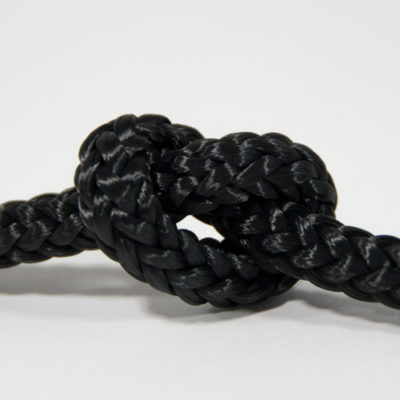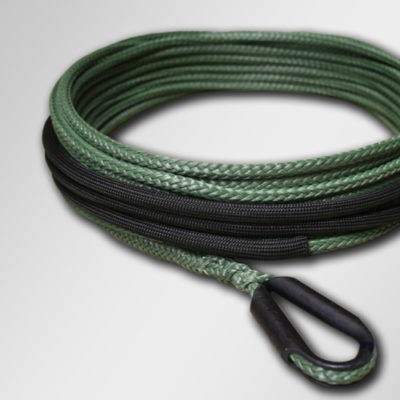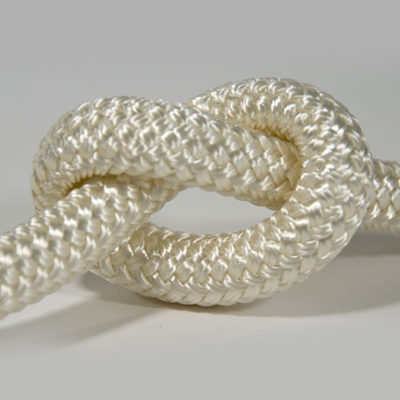Manufacturing companies choose to use Dyneema rope over steel wire rope for heavy lifting applications such as heavy lift slings, crane rope, and other rigging operations because Dyneema rope:
- Is 15x stronger than steel wire rope
- Has a recoil force that is considerably less than steel wire rope
- Has an abrasion lifetime that is 4x longer than steel wire rope
- Is 7x lighter than steel wire rope at the same strength
Dyneema fiber rope is made from Ultra-High Molecular Weight Polyethylene (UHMWPE) fiber. Dyneema 12 strand rope is a common Dyneema fibered rope used for heavy-duty rigging applications. USA Rope & Recovery manufactures several different types of Dyneema fiber rope including the popular 12 Strand, and 24 Strand ropes, as well as others. No matter the application, USA Rope provides strong, durable, and efficient rope for the marine, arborist, nautical, off-roading, and other manufacturing industries.
Compare Strength and Breakage of Dyneema Rope vs. Steel Wire Rope for Manufacturers
More times than not, Dyneema fiber rope and steel wire rope are compared by most manufacturing companies–like The Rigging Company –for certain maritime, mooring, and towing rope applications. Pound for pound, Dyneema fiber rope is up to 15 times stronger than steel and up to 40% stronger than aramid fibers–otherwise known as Kevlar rope. The high-performance strength and low weight of Dyneema rope ensures that it is safer to use than steel wire rope. Ideally, Manufacturing companies want a rope that can withstand tremendous weight while being light enough to move, use, and work with when needed. Traditionally, steel wire rope is used for heavy-duty maritime, rigging, and mooring rope applications. Although steel wire rope is known for being used for heavy-duty rigging, the disadvantage is the serious risks that come from its heavy-weight and uneven breakage behavior. When a steel wire rope breaks, the combination of the enormous energy and incredible force causes unpredictable recoil. This unpredictable recoil comes from how wire rope is coiled. Essentially, wire rope is several strands of metal wire twisted into a helix, forming a composite rope. When breakage occurs, the helix formed rope unravels, creating a snaking behavior which can cause sharp edges of the broken strands to release at a dangerous force. The lack of strength compared to Dyneema rope shows that steel wire rope is more susceptible to breaking. This can increase risk factors for manufacturing companies that use steel wire rope for rigging, mooring, and heavy duty lifting.
For example, when comparing a ⅜ inch 12 Strand Dyneema rope to a ⅜ inch steel wire rope, the 12 strand Dyneema rope is significantly stronger and presents safer breaking characteristics. The ⅜ inch steel wire rope withstands a load of 14,478 pounds. As the video shows, even in the event of a partial rupture, the steel wire ropes higher mass and recoil provides a greater risk over 12 Strand Dyneema rope. With a ⅜ inch 12 Strand Dyneema rope, it can withstand 18,857 pounds. With the Dyneema fibers low mass and recoil, it reduces the risks for manufacturing companies using rigging rope for heavy-duty lifting applications.
Dyneema is 7 times lighter than steel wire rope at the same strength. In the event of a break, the recoil force is considerably less. Furthermore, the different construction of a Dyneema rope shows a linear recoil without any snaking behavior. This is due to the fact that Dyneema rope is manufactured from UHMWPE, which is comprised of extremely long chains of polyethylene oriented in the same direction, resulting in an overlapping effect. The overlapping of the UHMWPE increases the bond of the chains and thereby strengthens the Dyneema fiber. Dyneema rope offers durable characteristics that can withstand an immense amount of strength while having very little weight to the rope. Because Dyneema fiber is lighter and has a lesser impact when breakage occurs, choosing Dyneema rope over steel wire rope is the safer choice for manufacturing companies working with heavy lifting and below the hook rigging applications for the industrial, nautical, and arborist industries.
Choosing the Best Rope for Maritime, Mooring & Towing, and Heavy-Duty lifting Applications
When choosing the best rope for any maritime, mooring, towing, or heavy-duty lifting application, choose a rope that can withstand extremely heavy loads and has a long enough lifetime to handle external factors in the nautical, industrial, or arborist industry. In order to decide which rope is best for the job, there are four main challenges that rigging, heavy-duty lifting, mooring, and towing ropes need to overcome:
- Abrasion
- Bending-Fatigue
- Compression
- Creep-Fatigue
Dyneema rope is the only high modulus synthetic fiber that has been scientifically engineered–from Ultra-High Molecular Weight Polyethylene (UHMWPE)–to overcome all four of these challenges. Dyneema is the world’s strongest fiber producing ropes that are 15 times stronger than steel wire ropes of the same weight and has become one the most trusted fiber ropes over generic HMPE ropes and steel cable wire ropes for all rigging, maritime, mooring, and towing rope applications.
Abrasion
Manufacturing companies that work with maritime and mooring applications need a durable rigging rope to withstand the constant pulling that comes from the rope running through fairleads and over capstans. Also, in heavy-duty lifting and towing applications, ropes come in contact with rough surfaces such as chocks and the vessel’s deck. These applications can potentially provide severe abrasions to the ropes and degrade the exposed fibers, eventually breaking them. Choosing a Dyneema fibered rope provides manufacturers with a durable, lightweight rope that carries an abrasion lifetime that is four times longer than steel wire rope and rope made with regular HMPE and polyester. With Dyneema’s extended abrasion lifetime, manufacturers are choosing Dyneema rope over steel wire rope for all mooring, towing, maritime, and heavy-duty lifting applications throughout the nautical, arborist, and industrial industries.
Compression and Bending-Fatigue
Bending fatigue occurs every time a rope flexes under tension. For heavy-duty lifting applications, rope experiences potential bending-fatigue every time something needs to be moved. For example, when a steel beam manufacturer has completed a 15-ton custom-made beam for a military-grade application, the finished product needs to be moved onto a truck for shipment. Rigging ropes are then attached to a crane to then lift, move and place the steel beam from the warehouse to the truck. This can wear out the rope. Another example is when the rope runs over fairleads and pedestals in maritime and mooring applications. This stresses the fiber both inside and outside of the rope causing bending fatigue and decreases the useful life of the rope. Certain conditions in towing and mooring applications can also lead to compression fatigue. This happens when ropes become slack during services and the fibers compress. Due to the molecular properties (UHMWPE) engineered to make Dyneema fiber– and its extremely long chains of polyethylene oriented in the same direction–threats of compression and bending fatigue are far less over other synthetic fibers and steel wire ropes.
Creep-Fatigue
In all rigging applications, synthetic ropes elongate when over a long period of time when loaded in higher temperatures–commonly referred to as creep. Creep is irreversible and when combined with abrasions or other risks, it can lead to rope failure. With regular HMPE rope, in heavy-duty lifting and towing applications where high loads and high temperatures are constantly a factor, the creep process can accelerate. This can be a major risk for ropes made from generic HMPE. In contrast, Dyneema rope has up to four times longer creep lifetime. When comparing Dyneema fiber to Spectra, another synthetic fiber rope, under 122 degrees Fahrenheit and 600 MPa load, Dyneema rope has a significantly longer creep lifetime than Spectra fiber rope.
USA Rope & Recovery– Manufacturing Rope for B2B Companies
e After comparing Dyneema rope to steel wire rope–a ⅜ inch 12 Strand Dyneema rope to a ⅜ inch steel wire rope–there is a guarantee that Dyneema rope is 15 times stronger and better at dealing with abrasions over steel wire rope. For manufacturing companies, Dyneema rope is also considered to be superior to Nylon rope due to Dyneema fiber having low ability to stretch, is UV resistant, and possesses an immense amount of strength. USA Rope properly manufactures Dyneema fibered ropes that are synthetically engineered to uphold incredible weight while enduring constant friction for application uses involving heavy-duty lifting, crane rope support, and below the hook rigging.
Understanding that Dyneema fiber rope is better used for manufacturing companies over steel wire rope, USA Rope & Recovery works hard to manufacture the highest quality rope by using top-of-the-line supplies from across the USA. Dedicating time and effort to finding the next best and technologically advanced products in the market is our main goal at USA Rope in order to help our customers gain the best competitive advantage in their respective field. USA Rope & Recovery also manufactures additional ropes including Spectra, Nylon, Polyester, Polypro, and Kevlar (Aramid) fiber ropes. No matter the application, USA Rope is a leader in custom rope manufacturing for industries including nautical, industrial, arborist, and marine.
Frequently Asked Questions
What are Some of the Different Type of Dyneema Fiber Rope?
There are various types of Dyneema fiber rope. USA Rope & Recovery makes the following:
When Should I Replace my Rigging Rope?
In general, running rigging should be replaced whenever it shows visible signs of damage – core hemorrhaged through the cover, several broken strands close together, “rot” from UV exposure, or green and stiff from disuse. There’s a rule of thumb, but it varies rigger to rigger. The Rule of thumb says to replace all rigging hardware every 5-10 years. However, depending on how much everyday usage, weight, and environmental factors the rigging ropes take on can make the rule of thumb shorter or longer.
Why Dyneema Fiber Rope Over Other Synthetic Fiber Ropes?
There are multiple different types of synthetic winch lines available today, many of them are made from Dyneema fibers, while others are made from Polyester, Nylon, Spectra, or Kevlar. Each fiber has benefits and disadvantages and can be chosen depending on your unique application. Spectra is similar to Dyneema fiber but is not as strong or as durable. Because of its strength and durability, Dyneema is the premier synthetic fiber for winching applications.




can dyneema rope carry a man in air???
I’m considering replacing the 5/16″ steel cable on my 4-piling residential boat lift with Dyneema.
Do you have any information about this specific application of Dyneema? Do you have any recommendations about the size Dyneema I should consider?
I am very interested in the 12 strand dynema to replace a wire rope halyard. The existing sheave is for a wire rope, does it have to be changed to accommodate dynema?
I am very interested in the 12 strand dynema to replace a wire rope halyard? Should I replace it with the same size?
Looking for a cable …can’t be cut. I have to chain my back pack blower on my truck. But the thieves cut my cable and steal the blowers.
I posed a question to crane operations at SpaceX: would they be better to use Dyneema verses wire rope to lift Starship. As you may know Starship is extremely heavy, I believe they are using steel cable. Would they be better served with Dyneema?
They said cost and UV degradation is the factors they would not use it. What do you say?
I’d like to see Dyneema fabric. Simply, interested. Where might I find it near Grand Rapids, Michigan?
I think that for a comparable diameter Dynema stretches far more than multi strand flexible stainless steel wire rope under the same loading. Can you confirm this and supply some figures that I can compare.
Dyneema 1/16” (1.57 mm) is rated to 302 lbs.
Aircraft control cable 1/16” is rated to 385 lbs.
How is Dyneema stronger? Please educate me.
I’m looking to replace the steel cables carrying our volleyball nets with with either kevlar (aramid) or dyneema rope.
Volleyball net cables are general pulled to a very high tension to keep the catenary effect to a minimum. In this respect, how would dyneema rope compare to steel cable?
For dragging full length tree logs into a more open area using rigging and a winch which line type and size would be recommended and could you recommend a winch for the application?